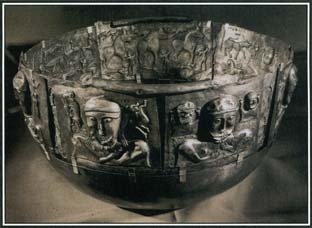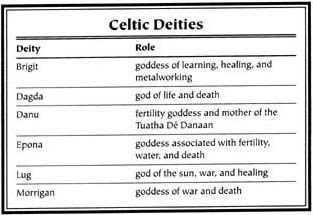Celtic Mythology
Adventure, heroism, romance, and magic are a few of the elements that make Celtic mythology one of the most entrancing mythologies of Europe. Once a powerful people who dominated much of Europe, the Celts were reduced to a few small groups after the Roman invasions. However, their mythology survived, thanks largely to the efforts of medieval Irish and Welsh monks who wrote down the stories.
The Celts
The Celts were a group of people who began to spread throughout Europe in the 1000s B . C . At the peak of their power, they inhabited an area extending from the British Isles in the west to what is now Turkey in the east. They conquered northern Italy and Macedonia, plundering both Rome and Delphi in the process. They had a reputation as fierce and courageous warriors and were viewed with respect by the Romans.
Celtic expansion reached its limit around 225 B . C ., when the Celts suffered the first in a series of defeats by the armies of the Roman empire. Gradually, the Romans subdued the Celts, and by A . D . 84, most of Britain was under Roman rule. At the same time, Germanic peoples conquered the Celts living in central Europe.
Just a few areas, notably Ireland and northern Britain, managed to remain free and to continue and pass on the Celtic traditions. Six groups of Celts have survived to modern times: the peoples of Ireland, Scotland, the Isle of Man, Wales, Cornwall, and Brittany.
The ancient Celts were neither a race nor a nation. They were a varied people bound together by language, customs, and religion rather than by any centralized government. They lived off the land, farming and raising stock. No towns existed apart from impressive hill forts. However, by about 100 B . C ., large groups of Celts had begun to gather at certain settlements to trade with one another.
Celtic society had a clearly defined structure. Highest in rank was the king, who ruled a particular tribe, or group of people. Each tribe was divided into three classes: the noble knights and warriors, the Druids (religious leaders), and the farmers and commoners. The Druids, who came from noble families, were respected and influential figures. They served not only as priests but also as judges, teachers, and advisers. In addition, it was widely believed that the Druids had magical powers.
The Myths
The ancient Celts had a vibrant mythology made up of hundreds of tales. They did not, however, record their myths in writing but passed them on orally. Our knowledge of the gods, heroes, and villains of Celtic mythology comes from other sources—mainly Roman. Yet the Romans sometimes referred to Celtic gods by Roman names, so their accounts were not always reliable. Moreover, because the Romans and Celts were battlefield enemies, Roman descriptions of Celtic beliefs were often unfavorable.
The Tragedy of Deirdre
The heroine of the Ulster Cycle is the beautiful Deirdre. King Conchobhar intends to marry the young woman, but she falls in love with Naoise and flees to Scotland with him. When they return, the king has Naoise killed.
Forced to lived with Conchobhar, the grief-stricken Deirdre never smiles and makes clear to the king how much she hates him. The story ends with Deirdre taking her own life by striking her head against a rock. Deirdre's tragic tale served as inspiration for poetry, plays, and stories by later Irish writers, including William Butler Yeats and J. M. Synge.
medieval relating to the Middle Ages in Europe, a period from about A . D . 500 to 1500
Much of what is now known about Celtic mythology is based on manuscripts that were prepared by monks in the Middle Ages. Irish collections dating from the 700s and Welsh collections from the 1300s recount many of the myths and legends of the ancient Celts.
* See Nantes and Places at the end of this volume for further information.
Major Gods. The Celts worshiped a variety of gods who appeared in their tales. Most were all-powerful local deities rather than gods with specialized roles. Each tribe had its own god, who protected and provided for the welfare of that tribe. Some of them had similar characteristics. For example, Dagda, the god of life and death in Ireland—known as the good god—resembled Esus, the "master" god of Gaul.
Some deities had more clearly defined roles. Among these were Lug, or Lugus, a sun god associated with arts and skills, war and healing, and the horned god Cernunnos, who was god of animals and fertility. The Celts also had a large number of important female deities. These included Morrigan, the "Great Queen"—actually three war goddesses, Morrigan, Badb, and Nemain, who appeared as ravens during battle. Another important deity was Brigit, goddess of learning, healing, and metalworking. Epona, the horse goddess, was associated with fertility, water, and death.
Major Themes. Magic, magicians, and the supernatural played a significant role in Celtic mythology. A common theme was the magic cauldron. The cauldron of plenty was never empty and supplied great quantities of food. The cauldron of rebirth brought slain warriors to life again. Myrddin, a magician in the Welsh tales, later became Merlin in the Arthurian legends*.
deity god or goddess
supernatural related to forces beyond the normal world; magical or miraculous cauldron large kettle
Other important themes in the myths were voyages to mysterious and dangerous lands and larger-than-life heroes. The heroes experienced all kinds of adventures and often had to perform impossible tasks before marrying their loved one. Love, romance, and mischief also figured prominently. The gods played tricks on humans and on one another. Animals changed shape at will.


| Celtic Deities | |
| Deity | Role |
| Brigit | goddess of learning, healing, and metalworking |
| Dagda | god of life and death |
| Danu | fertility goddess and mother of the Tuatha Dé Danaan |
| Epona | goddess associated with fertility, water, and death |
| Lug | god of the sun, war, and healing |
| Morrigan | goddess of war and death |
Many myths told of the otherworld. In this mysterious place, there was no work and no death, and the gods and spirits who lived there never got old. The Celts believed that humans could enter this enchanted place through burial mounds called sídhe, through caves or lakes, or after completing a perilous journey. After reaching the otherworld, they would live happily for all time.
Irish and Welsh Legends
Early Irish myths blend mythology and history by describing how Ireland was settled by different groups of Celtic deities and humans. Filled with magic and excitement, the tales tell of battles between forces of light and darkness. They describe a time when gods lived not in the heavens but on earth, using their powers to create civilization in Ireland and to bring fertility to the land.
There are four cycles, or groups, of connected stories. The Mythological Cycle focuses on the activities of the Celtic gods, describing how five races of supernatural beings battled to gain control of Ireland. The chief god was Dagda, whose magic cauldron could bring the dead back to life. The Ulster Cycle recounts the deeds of warriors and heroes, especially Cuchulain, the warrior and champion of Ireland. The Historical Cycle tells of the adventures and battles of legendary Irish kings. The Fenian Cycle deals with the heroic Finn Mac Cumhail, or Finn Mac Cool, leader of a band of bold warriors known as the Fianna. This cycle is filled with exciting adventures and tales of hand-to-hand combat.
Welsh mythology is found in the Mabinogion, a collection of 11 tales. In the Welsh myths, as in those of Ireland, the heroes often are half human and half divine and may have magical powers. Many of the stories in the Mabinogion deal with Arthurian legends, accounts of the deeds of Britain's heroic King Arthur and his knights.
Related Entries
Other entries related to Celtic mythology are listed at the end of this article.
In fact, the popular Arthurian tales of medieval European literature are a complex blend of ancient Celtic myths, later stories, and
* See Names and Places at the end of this volume for further information.
historical events. The legends are clearly rooted in Celtic mythology however, and references to Arthur appear in a number of ancient Welsh poems. Scholars also note that there are many similarities between the Arthur stories and the tales of the Irish Finn Mac Cumhail, suggesting a shared Celtic origin.
Another famous romantic story of Celtic origin is that of Tristan and Isolde. The tragic tale, probably based on an early Cornish poem, concerns the knight Tristan who falls in love with Isolde, a princess who is feted to marry his uncle the king. In the Middle Ages, Gottfried von Strassburg wrote a poem based on the legend that is considered a literary masterpiece.
See also Arthurian Legends ; Badb ; Cuchulain ; Dagda ; ; Druids ; Finn ; Lug ; Tristan and Isolde .